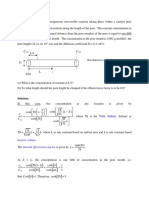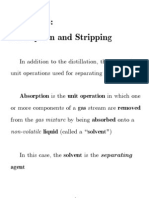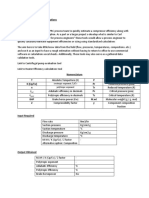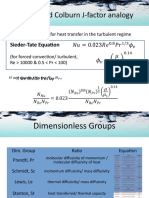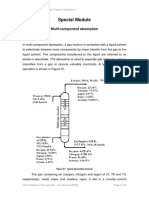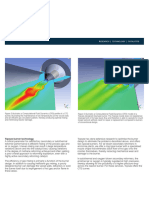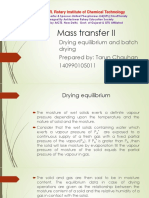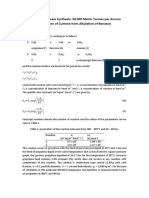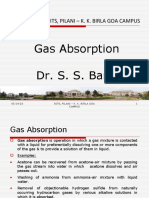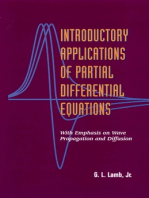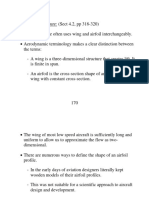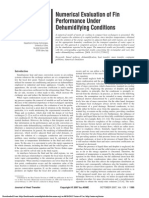Analogies of Transport Properties
Analogies of Transport Properties
Uploaded by
AB DevilierCopyright:
Available Formats
Analogies of Transport Properties
Analogies of Transport Properties
Uploaded by
AB DevilierOriginal Description:
Copyright
Available Formats
Share this document
Did you find this document useful?
Is this content inappropriate?
Copyright:
Available Formats
Analogies of Transport Properties
Analogies of Transport Properties
Uploaded by
AB DevilierCopyright:
Available Formats
P.C.
Chau (UCSD, 1999)
Analogies of transport properties Behind the development of the Reynolds and Chilton-Colburn analogies is the appreciation that there are certain similarities among the transport of momentum, mass, and energy. Transport phenomena is the integrated study of these three physical propertiesthey intertwine under many circumstances. Generally, since concentration and temperature are scalar quantities, analogies between mass and heat transport are more valid than those with momentum. Nevertheless, with proper definitions, the transports of these quantities all depend on transport coefficients with the units of [length2/time]kinematic viscosity, diffusivity, and thermal diffusivity. This is why kinematic viscosity is also called momentum diffusivity. The flux laws of these quantitiesNewton's law of viscosity, Fick's law, and Fourier's lawall share the same linear constitutive equation. Certainly, we may also identify similar features in their conservation equations. The idea is that, say, when we solve a diffusion problem, we may want to find the solution of a similar heat conduction problem. The main motivation underlying the establishment of transport analogies, however, is that we can take experimental measurements or correlations in one system, and apply it to another. For example, we can apply heat transfer data to a mass transport problem where experimentation with mass transport may be difficult. This is particularly important with turbulent flow. (You'd see more advanced analogies in a graduate level course.) For now, keep the following table handy. Table 1. Analogous quantities in transport phenomena Momentum Transport quantity per volume Transport coefficient Diffusivity [cm2.s1] Flux law ux Mass CA Energy CpT
[g.cm1s1]
DAB [cm2.s1] DAB
k [cal.cm1s1K1] = k/Cp
= / xz = d (u x) dz Re = UL
J z = D AB d C A dz Sc = D
q z = d (C pT) dz = C p Pr = k L Nu h = h C p Pe = RePr = UL Nu h h St = RePr = C U
p
Dimensionless transport groups Other dimensionless groups used in transport correlations
AB
k L Nu m = Dc AB UL Pe = ReSc = D Nu m k c St = ReSc = U
AB
For turbulent transport: Reynolds analogy (Sc = Pr = 1) Chilton-Colburn j-factor
f 2 f 2
kc U k c 2/3 Nu m U Sc = Re Sc 1/3
h C p U Nu h 2/3 h C p U Pr = Re Pr 1/3
Note: The cgs unit of viscosity is the same as a poise. Strictly speaking, the Fick's law should be defined on the basis on a mole fraction gradient. Num is the same as the Sherwoord number (Sh). Also, we may find the Lewis number defined as Le = Pr/Sc = DAB/.
P.C. Chau (UCSD, 1999)
Reynolds Analogy Here are the derivation steps to clarify Section 6.2. From fluid dynamics (AMES 103A), the friction factor is defined as
f= 1 w 2 U 2
Free-stream velocity, U
Turbulent flow
(1)
Uniform laminar boundry layer Representation of the uniform boundary layer model.
We consider flow over a flat plate. If we assume a simple shear flow in a uniform laminar boundary layer, we can approximate the wall stress as w U
(2)
where U is the free-stream velocity and is fictitious uniform boundary layer thickness. So,
U U = 1 = 1 2 w U f 2 U f 2
(3)
and dividing by the length of the flat plate, L:
= 1 , L 1 UL f 1 Re L f 2 2
where Re L = UL
(4)
Next, we define the Sherwood number
Sh L = kL D AB
(5)
is based on the film model and some which is based on the length scale L. The average mass transfer coefficient k concentration boundary layer thickness c:
k= D AB c D AB L = L =L c D AB c c
(6)
Thus
Sh L =
(7)
Finally, we know from scaling analysis that when Sc = 1, = c, and thus the Sherwood number can be evaluated as 1 kL = L = 2 UL f D AB If we equate the very first and last terms,
1f = k U 2
(8)
since /DAB = 1. This is the Reynolds analogy which relates the friction factor to the mass transfer coefficient.
If we invoke Blasius formula for turbulent flow, the friction factor is f = 0.0791 Re1/4, and we have the functional dependence /L ~ Re3/4.
P.C. Chau (UCSD, 1999)
Chilton-Colburn Analogy We now take Sc 1, and use Eq. (7). Thus we need to say something about the ratio /c. From a proper scaling or from a boundary layer analysis, we should find that /c ~ Sc1/3. We use this relation in (7), and further substitute for /L by Eq. (4), and we have
Sh L = 1 Re L f Sc 1/3 2
and rearrangement gives
1 f = Sh L = j D 2 Re LSc 1/3
(9)
which is the Chilton-Colburn analogy, and the mass transfer term on the RHS is also called the j-factor, jD. Note that we can also write
D AB Sh L = kL 1/3 UL D AB Re LSc
1/3
= k U D AB
2/3
(10)
where we can further define St = k/U as the Stanton number.
You might also like
- Solution:: Cosh Cosh 1 Cosh CoshDocument2 pagesSolution:: Cosh Cosh 1 Cosh CoshVaibhav GuptaNo ratings yet
- Problem 12Document8 pagesProblem 12LINDOH0% (1)
- Heat TranferDocument17 pagesHeat TranferLuis González Cos Alcocer100% (1)
- Lab With Index1Document35 pagesLab With Index1Labdhi ShahNo ratings yet
- MasstransfernotesallDocument19 pagesMasstransfernotesallapi-354955216No ratings yet
- Convective Mass TransferDocument13 pagesConvective Mass TransferAriadne ChuaNo ratings yet
- Lab-6-Binomail and Poisson DistributionDocument13 pagesLab-6-Binomail and Poisson DistributionRakib Khan100% (1)
- Capital Cost EstimationDocument29 pagesCapital Cost EstimationZati TarhiziNo ratings yet
- Polytropic Process1Document4 pagesPolytropic Process1Manash SinghaNo ratings yet
- Absorption and StrippingDocument60 pagesAbsorption and StrippingMyvizhi Somasundaram100% (2)
- Homework 1Document9 pagesHomework 1AgithaNo ratings yet
- Process Dynamics & Control: Muhammad Rashed JavedDocument33 pagesProcess Dynamics & Control: Muhammad Rashed JavedTalha ImtiazNo ratings yet
- Compression With IntercoolingDocument8 pagesCompression With IntercoolingDerrick Maatla MoadiNo ratings yet
- AbsorptionDocument54 pagesAbsorptionBebo El MasryNo ratings yet
- Hot Potassium Carbonate Process - OdtDocument2 pagesHot Potassium Carbonate Process - OdtMahmoud HendawyNo ratings yet
- Reaction Kinetics (3) : Xuan Cheng Xiamen UniversityDocument35 pagesReaction Kinetics (3) : Xuan Cheng Xiamen Universityahmadhelmiase7621No ratings yet
- Chapter 5 AdsorptionDocument46 pagesChapter 5 AdsorptionSyahmiNo ratings yet
- Intrinsic and Global Reaction Rate of Methanol Dehydration Over G Al2O3 Pellets 1992 Industrial and Engineering Chemistry Research1992Document7 pagesIntrinsic and Global Reaction Rate of Methanol Dehydration Over G Al2O3 Pellets 1992 Industrial and Engineering Chemistry Research1992pannita.kNo ratings yet
- Compressors Efficiency Calculations5Document11 pagesCompressors Efficiency Calculations5Ahmed HassanNo ratings yet
- Chilton and Colburn J-Factor Analogy: Sieder-Tate EquationDocument23 pagesChilton and Colburn J-Factor Analogy: Sieder-Tate EquationAnkan ChaudhuryNo ratings yet
- HT UnaDocument128 pagesHT UnaChetana PatilNo ratings yet
- Mass Transfer Operations (ENV 425) Problem Set 4: Zewail City of Science and TechnologyDocument3 pagesMass Transfer Operations (ENV 425) Problem Set 4: Zewail City of Science and TechnologyMayar H. HaggagNo ratings yet
- CRE 1-3 Unit (2016-2017) PDFDocument56 pagesCRE 1-3 Unit (2016-2017) PDFgouthamNo ratings yet
- Special ModuleDocument6 pagesSpecial ModuleMrinal BiswasNo ratings yet
- RCMDocument15 pagesRCMAdzamNo ratings yet
- All ProblemsDocument29 pagesAll Problemsahmed hatemNo ratings yet
- CP302 MassTransfer 02 OKDocument38 pagesCP302 MassTransfer 02 OKDeneshVijayNo ratings yet
- Haldor Topsoe Ammonia Part3Document4 pagesHaldor Topsoe Ammonia Part3tatoo1No ratings yet
- Week 4 - Vapor-Liquid Separation (Multicomponent Distillation)Document19 pagesWeek 4 - Vapor-Liquid Separation (Multicomponent Distillation)psychopassNo ratings yet
- Che Lab 1 (Gas Ab/Adsorption) : Engr. Mary Jane C. Calagui Che Department CsuDocument18 pagesChe Lab 1 (Gas Ab/Adsorption) : Engr. Mary Jane C. Calagui Che Department CsuEmmanuel JimenezNo ratings yet
- 13 Reaction Kinetics (S)Document32 pages13 Reaction Kinetics (S)Mr TanNo ratings yet
- Ch4 Steam NozzleDocument10 pagesCh4 Steam Nozzleمحمد احمد گاطعNo ratings yet
- Laws of Thermodynamics - NewDocument20 pagesLaws of Thermodynamics - NewPeter CheaNo ratings yet
- Design of Fixed Bed Adsorption Columns: CENG 4710 Environmental ControlDocument17 pagesDesign of Fixed Bed Adsorption Columns: CENG 4710 Environmental ControlchetanNo ratings yet
- Auxiliary VesselDocument3 pagesAuxiliary VesselSachin5586No ratings yet
- Equivalent Hydraulic DiameterDocument3 pagesEquivalent Hydraulic DiameterSyeilendra PramudityaNo ratings yet
- Gas Absorption and Gas StrippingDocument14 pagesGas Absorption and Gas StrippingEK63No ratings yet
- LECTURE - 4: ChloromethaneDocument4 pagesLECTURE - 4: Chloromethaneمحمود محمدNo ratings yet
- Unsteady State Heat and Mass TransferDocument14 pagesUnsteady State Heat and Mass Transfernhalieza1067No ratings yet
- Mass Transfer 2Document102 pagesMass Transfer 2acharyarameswar1No ratings yet
- 1.cre IntroDocument33 pages1.cre IntroArunPThomasNo ratings yet
- Chapter 4 Heat EffectsDocument6 pagesChapter 4 Heat Effectsariana religiosoNo ratings yet
- Drying EquilibriaDocument13 pagesDrying EquilibriaChintan Modi100% (1)
- Lecture 14 15 AmmoniaDocument32 pagesLecture 14 15 AmmoniaAnilKumarNo ratings yet
- 2.heat-Exchangers From Ch6 - Mihir's HandbookDocument12 pages2.heat-Exchangers From Ch6 - Mihir's HandbookThế Quang LêNo ratings yet
- Answer For Assignment 1 Sem21920Document19 pagesAnswer For Assignment 1 Sem21920Ahmad Faiz100% (1)
- CHEG411 Chemical Reaction Engineeirng. F PDFDocument206 pagesCHEG411 Chemical Reaction Engineeirng. F PDFSarang GohNo ratings yet
- Gas AbsorptionDocument70 pagesGas AbsorptionLucho BetoNo ratings yet
- Soln Sa Adsorption PDFDocument2 pagesSoln Sa Adsorption PDFRee ValeraNo ratings yet
- Heat 4e Chap11 LectureDocument32 pagesHeat 4e Chap11 LectureSalim ChohanNo ratings yet
- ExtractionDocument37 pagesExtractionDeepika dipsiNo ratings yet
- Handout For DiffiusionDocument2 pagesHandout For DiffiusionAbdulrazzaqAL-MalikyNo ratings yet
- Gas AbsorptionDocument42 pagesGas AbsorptionRishab Srivatsa100% (1)
- Distillation - Written ReportDocument17 pagesDistillation - Written ReportmichsantosNo ratings yet
- Crystallization 2Document10 pagesCrystallization 2Ralph EvidenteNo ratings yet
- Gas Absorption Theory, Apparatus, ProcedureDocument16 pagesGas Absorption Theory, Apparatus, Proceduresolehah misni100% (1)
- Introductory Applications of Partial Differential Equations: With Emphasis on Wave Propagation and DiffusionFrom EverandIntroductory Applications of Partial Differential Equations: With Emphasis on Wave Propagation and DiffusionNo ratings yet
- Aerofoil ClassificationDocument21 pagesAerofoil ClassificationAB DevilierNo ratings yet
- Ielts Form EorDocument1 pageIelts Form EorAB DevilierNo ratings yet
- Endeavour FormDocument13 pagesEndeavour FormAB DevilierNo ratings yet
- Heat TransferDocument8 pagesHeat TransferAB DevilierNo ratings yet
- 2015 Spring Graduate Program Admission GuidelineDocument11 pages2015 Spring Graduate Program Admission GuidelineAB DevilierNo ratings yet
- 2D Separation of Variables in Cylindrical Coordinates: QZ T R KDocument11 pages2D Separation of Variables in Cylindrical Coordinates: QZ T R KAB DevilierNo ratings yet
- Achaichia A, Cowell TA (1988) Heat Transfer and Pressure Drop Characteristics of Flat Tube and Louvered Plate Fin Surfaces PDFDocument11 pagesAchaichia A, Cowell TA (1988) Heat Transfer and Pressure Drop Characteristics of Flat Tube and Louvered Plate Fin Surfaces PDFAB Devilier100% (1)

